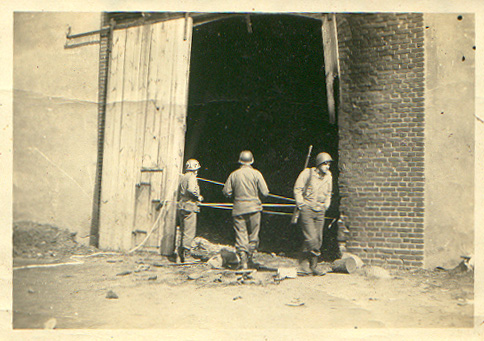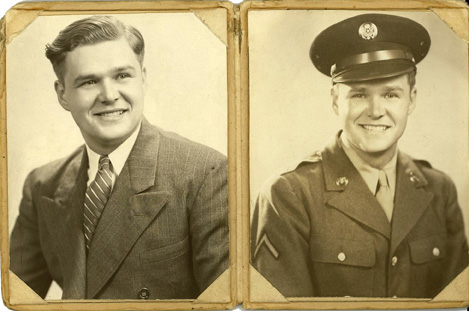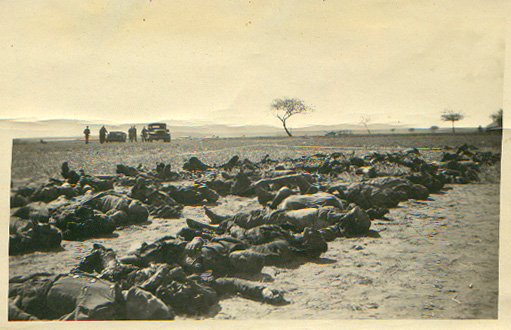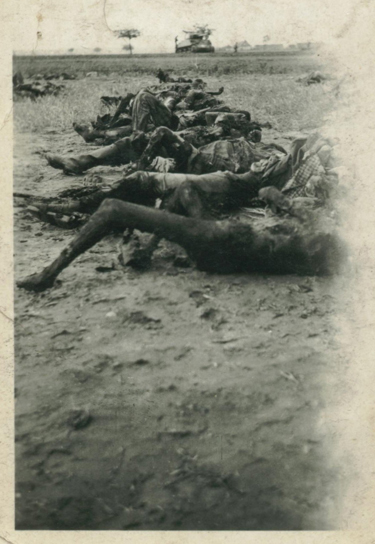Gardelegen Massacre, 13 April 1945 The photograph above was taken by Captain Weldon W. Wilson, who was one of the first American soldiers on the scene on April 15, 1945. Captain Wilson is the soldier on the right in the photograph below. This photo and the one above were contributed by his son, Bill Wilson.   Clifford Rentz was an MP with the 102 Division of the US Ninth Army, nicknamed the Ozarks. The commander of the 102 Division, which was the first to arrive on the scene, was General Frank A. Keating; Rentz had previously served as General Keating's body guard and also as the body guard of General Fox at one time. T-4 Philip A. Feick, a soldier in the 132d Ordnance Medium Maintenance Company, 84th "Railsplitters" Division, was one of the eye-witnesses at the scene, a few days after the massacre. Feick wrote in a letter to his family about "a Jewish massacre that took place on a farm near Gardelegen Germany. It was a pitiful sight to see. Many were packed on hay in a large barn and the hay was set on fire as they fired incendiary bullets into it. Many were mowed down with machine gun fire as they stood in line. We calculated almost 1800 bodies in all." The photograph below, which was taken by Capt. Weldon W. Wilson, shows bodies laid out in a field near the barn. According to Feick, the prisoners were "murdered here" in the field. Feick had arrived on the scene after the massacre, but was told by a Polish prisoner, who had survived by hiding under the bodies in the barn, that hundreds of the victims were lined up in the field and machine-gunned to death.  On April 18, 1945, German citizens of Gardelegen began digging seven trenches for mass graves on the orders of General Frank A. Keating. The photo above shows the bodies laid out in preparation for burial. The photograph below was taken by J. Edgar, a soldier in the British army, and sent to us by Craig Tisbury. It shows bodies lined up in the field next to the barn at Gardelegen; in the background, one can see buildings in the town of Gardelegen and a tank coming towards the barn. Residents of the town of Gardelegen were escorted by American tanks on April 18, 1945 to the barn to begin burying the bodies.  The photograph below, taken by Capt. Weldon W. Wilson and sent to us by his son, Bill Wilson, shows what looks like the same scene. Note the bent leg of a prisoner that is shown in both photos.  Another witness who saw the dead bodies in the barn on April 15th was Ed Motsko, an American soldier. His description is as follows: I saw these people charred black from the smoke and fire. Most had the Star of David on their clothes. Some seemed very young, fourteen or sixteen years old. There were piles of bodies in front of the doors, still smoldering. The barn floor was dirt and some prisoners tried so hard to dig under the barn doors that they wore down the flesh and bone on their fingers up to the second joint. The following eye-witness account is an excerpt from the diary of Sgt. Gene Greenburg, Company F, 405th Regiment, 102nd Division, 2nd Battalion, US Ninth Army: Sunday, April 11 ....we suddenly ran into some stiff opposition. It seemed that S.S. troops in front of us were holding a town and were determined to fight to the end. Our battalion formed for the attack together with the tanks. The country was hilly and our co. was trying to flank the town. We suddenly came upon slave laborers in striped suits who went down on their knees begging us for food. They hadn't eaten in five days. Monday, April 12 We found out in the morning why we hadn't chased Jerry late last night. A surrender had been arranged for this morning at Gardelegen, a town about 30 miles away. A Jerry regiment was to formally surrender to our regiment. We boarded our trucks and took off to Gardelegen being on the alert and taking every precaution against a German trick. When we arrived the German regt. was lined up and proceeded to pile up their weapons and ammo. After this was done we found some pretty good quarters and made ourselves comfortable as we expected to stay here awhile. We were only a few miles from the Elbe and it seemed the war was bout over for us. Tuesday, April 13 It was while taking a walk with Racine and DiGiovanni that I came across the most horrible sight I had ever seen. We stopped to talk to a Polish woman for a minute and she pointed out a very large shed and told us to look in it. We went toward this building and on going into it we saw a sight that we would never forget. Inside the building were hundreds of bodies that were smoking. Later we learned the whole story. It seemed the night before we entered Gardelegen, SS troops took 1200 prisoners and put them inside this shed. The shed was filled with straw and all entrances were guarded with machine guns and bazookas. The Germans then proceeded to machine gun the men in cold blood. In the confusion that followed two prisoners escaped and that's how the story finally came out. When the Germans thought they killed everyone they poured gasoline on the bodies and lit it. While looking on this scene we heard a moan and found one man still alive. We called the medics and he was taken to the hospital but died the next morning. Within the next week all the Germans in the town were forced to pick up the bodies and dig graves for them. It wasn't pleasant work but Jerry was still getting off too easy. Gardelegen proved to any skeptic in the division that German atrocities were true. The dates of the entries are off by several days. The massacre occurred on the night of April 13th, which was on Friday, not Tuesday. American troops did not arrive until around 5 p.m. on April 14th; the barn was discovered on the morning of April 15, 1945, according to the Army report written after an investigation. Old Photos contributed by Ethel B. StarkKarel Margry's account of the massacreText of Memorial Site PamphletGermans forced to see the barnGermans forced to construct cemeteryCeremony at the cemeteryPrisoners who escapedGerhard Thiele ordered the massacrePamphlet made by 102nd DivisionHomeThis page was last updated on September 3, 2007 |